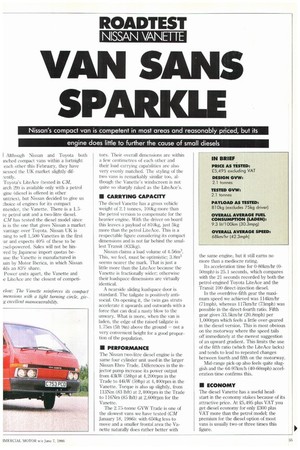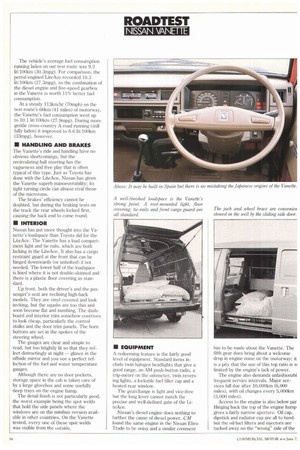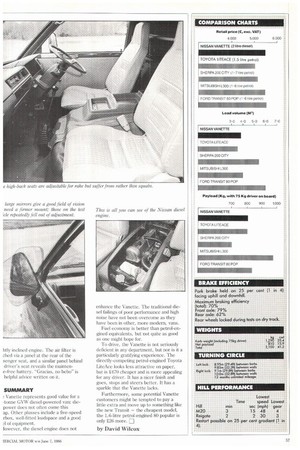VAN SANS
Page 55

Page 56

Page 57

If you've noticed an error in this article please click here to report it so we can fix it.
SPARKLE
Nissan's compact van is competent in most areas and reasonably priced, but its engine does little to further the cause of small diesels Although Nissan and Toyota both inched compact vans within a fortnight each other this February, they have sessed the UK market slightly difrently.
Toyota's LiteAce (tested in CM, arch 29) is available only with a petrol [gine (diesel is offered in other tuntries), but Nissan decided to give us choice of engines for its compact ntender, the Vanette. There is a 1.5re petrol unit and a two-litre diesel. CM has tested the diesel model since is is the one that gives Nissan a market lvantage over Toyota. Nissan UK is -ling to sell 1,500 Vanettes in the first ar and expects 40% of these to be .?sel-powered. Sales will not be hintred by Japanese import quotas beuse the Vanette is manufactured in min by Motor Iberica, in which Nissan ilds an 83% share.
Power units apart, the Vanette and e LiteAce are the closest of competi tors. Their overall dimensions are within a few centimetres of each other and their load carrying capabilities are also very evenly matched. The styling of the two vans is remarkably similar too, although the Vanette's windscreen is not quite so sharply raked as the LiteAce's.
• CARRYING CAPACITY The diesel Vanette has a gross vehicle weight of 2.1 tonnes, 100kg more than the petrol version to compensate for the heavier engine. With the driver on board this leaves a payload of 810kg, just 5kg more than the petrol LiteAce. This is a respectable figure considering its compact dimensions and is not far behind the smallest Transit (833kg).
Nissan claims a load volume of 4.56M1. This, we feel, must be optimistic; 3.8m3 seems nearer the mark. That is just a little more than the LiteAce because the Vanette is fractionally wider; otherwise their loadspace dimensions are virtually identical.
A nearside sliding loadspace door is standard. The tailgate is positively antisocial. On opening it, the twin gas struts accelerate it upwards and outwards with a force that can deal a nasty blow to the unwary. What is more, when the van is laden, the edge of the raised tailgate is 1.75m (511. 9in) above the ground — not a very convenient height for a good proportion of the population.
• PERFORMANCE The Nissan two-litre diesel engine is the same four cylinder unit used in the larger Nissan Ebro Trade. Differences in the injector pump increase its power output from 43kW (58hp) at 4,200rpm in the Trade to 44kW (59hp) at 4,400rpm in the Vanette. Torque is also up slightly, from 113Nm (83 lbft) at 2,400rpm in the Trade to 116Nm (85 lbft) at 2,600rpm for the Vanette.
The 2.75-tonne GVVY` Trade is one of the slowest vans we have tested (CM January 18, 1986): with 650kg less to move and a smaller frontal area the Vanette naturally does rather better with the same engine, but it still earns no more than a mediocre rating.
Its acceleration time for 0-80km/hr (050mph) is 25.1 seconds, which compares with the 21 seconds recorded by both the petrol-engined Toyota LiteAce and the Transit 100 direct-injection diesel In the overdrive-fifth gear the maximum speed we achieved was 1141onihr (71mph), whereas 1171maihr (73mph) was possible in the direct-fourth ratio. Fifth gear gives 33.5knyhr (20.8mph) per 1,000rpm which feels a little over-geared in the diesel version. This is most obvious on the motorway where the speed tails off immediately at the merest suggestion of an upward gradient. This limits the use of the fifth ratio (which the LiteAce lacks) and tends to lead to repeated changes between fourth and fifth on the motorway.
Mid-range pick-up also feels quite sluggish and the 64-97km/h (40-60mph) acceleration time confirms this.
• ECONOMY The diesel Vanette has a useful headstart in the economy stakes because of its attractive price. At £5,495 plus VAT you get diesel economy for only .2300 plus VAT more than the petrol model; the premium for the diesel option of most vans is usually two or three times this figure. The vehicle's average fuel consumption running laden on our test route was 9.3 lit/100km (30.3mpg). For comparison, the petrol-engined LiteAce recorded 10.3 lit/100km (27.3mpg), so the combination of the diesel engine and five-speed gearbox in the Vanette is worth 11% better fuel consumption.
At a steady 113km/hr (70mph) on the test route's 66km (41 miles) of motorway, the Vanette's fuel consumption went up to 10.1 lit/100km (27.9mpg). During more gentle cross-country A-road running (still fully laden) it improved to 8.6 lit/100km (33mpg), however.
• HANDLING AND BRAKES The Vanette's ride and handling have no obvious shortcomings, but the recirculating-ball steering has the vagueness and free play that is often typical of this type. Just as Toyota has done with the LiteAce, Nissan has given the Vanette superb manoeuvrability; its tight turning circle can almost rival those of the microvans.
The brakes' efficiency cannot be doubted, but during the braking tests on the track the rear wheels locked first, causing the back end to come round.
• INTERIOR
Nissan has put more thought into the Vanette's loadspace than Toyota did for the LiteAce. The Vanette has a load compartment light and tie rails, which are both lacking in the LiteAce. It also has a cargo restraint guard at the front that can be hinged downwards (or unbolted) if not needed. The lower half of the loadspace is lined where it is not double-skinned and there is a plastic floor covering as standard.
Up front, both the driver's and the passenger's seat are reclining high-back models. They are vinyl covered and look inviting, but the squabs are too thin and soon become flat and numbing. The dashboard and interior trim somehow contrives to look cheap, particularly the control stalks and the door trim panels. The horn buttons are set in the spokes of the steering wheel.
The gauges are clear and simple to read, but too brightly lit so that they reflect distractingly at night — glance in the offside mirror and you see a perfect reflection of the fuel and water temperature gauges.
Although there are no door pockets, storage space in the cab is taken care of by a large glovebox and some usefully deep trays on the engine hump.
The detail finish is not particularly good, the worst example being the spot welds that hold the side panels where the windows are on the minibus version available in other countries. On the Vanette tested, every one of these spot welds was visible from the outside. • EQUIPMENT A redeeming feature is the fairly good level of equipment. Standard items include twin halogen headlights that give a good range, an AM push-button radio, a trip-meter on the odometer, twin reversing lights, a lockable fuel filler cap and a heated rear window.
The gearchange is light and vice-free but the long lever cannot match the precise and well-defined gate of the LiteAce.
Nissan's diesel engine does nothing to further the cause of diesel power. CM found the same engine in the Nissan Ebro Trade to be noisy and a similar comment has to be made about the Vanette. The filth gear does bring about a welcome drop in engine noise on the motorway; it is a pity that the use of this top ratio is Si limited by the engine's Lack of power.
The engine also demands unfashionabl frequent service intervals. Major services fall due after 10,000km (6,000 miles), with oil changes every 5,000km (3,000 miles).
Access to the engine is also below par Hinging back the top of the engine hump gives a fairly narrow aperture. Oil cap, dipstick and radiator cap are all to hand, but the oil/fuel filters and injectors are tucked away on the "wrong" side of the htly inclined engine. The air filter is ched via a panel at the rear of the senger seat, and a similar panel behind driver's seat reveals the maintene-free battery. "Gracias. no bebo" is helpful advice written on it.
SUMMARY
Vanette represents good value for a -tonne GVW diesel-powered van; diepower does not often come this ap. Other plusses include a five-speed rbox, well-fitted loadspace and a good 61 of equipment.
Iowever, the diesel engine does not enhance the Vanette. The traditional diesel failings of poor performance and high noise have not been overcome as they have been in other, more modern, vans.
Fuel economy is better than petrol-engined equivalents, but not quite as good as one might hope for.
To drive, the Vanette is not seriously deficient in any department, but nor is it a particularly gratifying experience. The directly-competing petrol-engined Toyota LiteAce looks less attractive on paper, but is £470 cheaper and is more appealing for any driver, It has a nicer finish and goes, stops and steers better. It has a sparkle that the Vanette lacks.
Furthermore, some potential Vanette customers might be tempted to pay a little extra and move up to something like the new Transit — the cheapest model, the 1.6-litre petrol-engined 80 popular is only £26 more. E by David Wilcox




























































